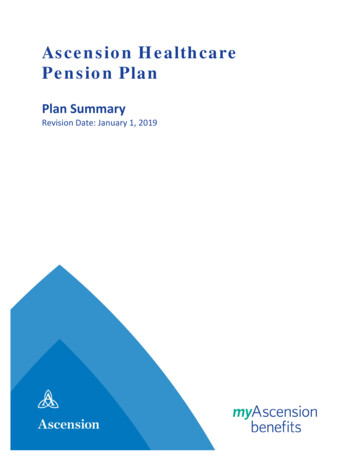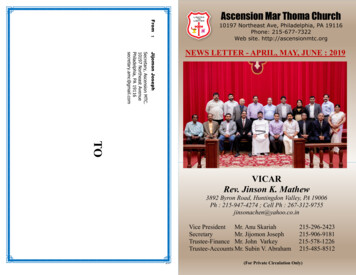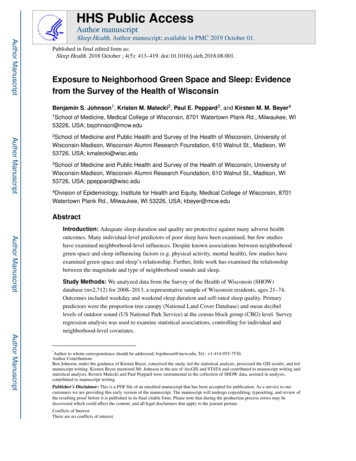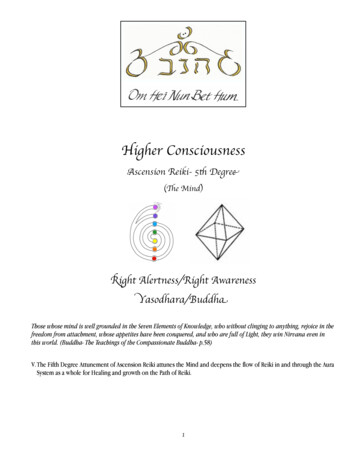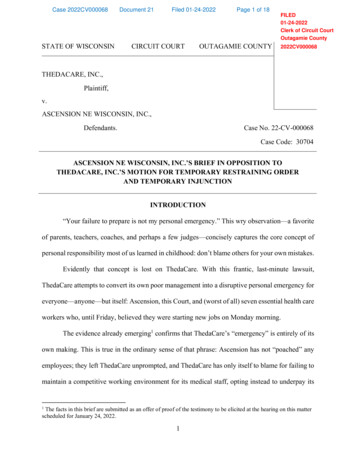
Transcription
Case 2022CV000068Document 21Filed 01-24-2022Page 1 of 18FILED01-24-2022Clerk of Circuit CourtOutagamie CountySTATE OF WISCONSINCIRCUIT COURTOUTAGAMIE COUNTY2022CV000068THEDACARE, INC.,Plaintiff,v.ASCENSION NE WISCONSIN, INC.,Defendants.Case No. 22-CV-000068Case Code: 30704ASCENSION NE WISCONSIN, INC.’S BRIEF IN OPPOSITION TOTHEDACARE, INC.’S MOTION FOR TEMPORARY RESTRAINING ORDERAND TEMPORARY INJUNCTIONINTRODUCTION“Your failure to prepare is not my personal emergency.” This wry observation—a favoriteof parents, teachers, coaches, and perhaps a few judges—concisely captures the core concept ofpersonal responsibility most of us learned in childhood: don’t blame others for your own mistakes.Evidently that concept is lost on ThedaCare. With this frantic, last-minute lawsuit,ThedaCare attempts to convert its own poor management into a disruptive personal emergency foreveryone—anyone—but itself: Ascension, this Court, and (worst of all) seven essential health careworkers who, until Friday, believed they were starting new jobs on Monday morning.The evidence already emerging1 confirms that ThedaCare’s “emergency” is entirely of itsown making. This is true in the ordinary sense of that phrase: Ascension has not “poached” anyemployees; they left ThedaCare unprompted, and ThedaCare has only itself to blame for failing tomaintain a competitive working environment for its medical staff, opting instead to underpay its1The facts in this brief are submitted as an offer of proof of the testimony to be elicited at the hearing on this matterscheduled for January 24, 2022.1
Case 2022CV000068Document 21Filed 01-24-2022Page 2 of 18essential workers and even refusing to make a matching offer to these employees when givenample opportunity to do so. Moreover, ThedaCare has known of this departure for weeks: theemployees announced their employment offers from Ascension on December 21 and theirresignations on December 29, and ThedaCare rejected multiple alternatives for retaining orreplacing them—some of which are still available to ThedaCare today—opting instead to wasteits money and everyone’s time on this frivolous lawsuit.But this emergency is also of ThedaCare’s making in a second, much more troubling sense:ThedaCare has invented the emergency ostensibly justifying this lawsuit. As the facts will show,allowing seven health care workers to leave ThedaCare for the hospital of their choosing—Ascension’s St. Elizabeth Hospital, not even seven miles away—will not plunge the Fox Valleyinto a critical care crisis, as ThedaCare claims. St. Elizabeth already offers the medical services atissue, just without the fancy designation ThedaCare appears to view as a better use of funds thanpaying its workers. And Green Bay is and will remain available as a backup option—no need fordiversion to Milwaukee or Madison. In short, this emergency is entirely of ThedaCare’s makingbecause ThedaCare is making it up.In that sense, it seems ThedaCare missed a second lesson of childhood: the story of the boywho cried wolf. Apparently ThedaCare hoped that if it moved quickly enough and prophesiedsufficiently dire consequences, it could get an injunction or perhaps just force a settlement beforeanyone looked too closely at the merits. Its after-hours court filings and its preemptive mediarelease appear calculated to do just that. But that strategy is now backfiring—and then some—asthe truth comes to light.That childhood story didn’t end well for the boy, and this lawsuit shouldn’t end well forThedaCare. Inventing an emergency and then blaming it on others is shameful behavior under any2
Case 2022CV000068Document 21Filed 01-24-2022Page 3 of 18circumstances; to take advantage of pandemic conditions on top of it is disgraceful. ThedaCarehas no legal leg to stand on and the facts clearly support Ascension. The Court should deny thepreliminary injunction, vacate the TRO, and leave ThedaCare on its own to fix the mess it made.RELEVANT FACTSI.ThedaCare’s “emergency” is manufactured.Reading ThedaCare’s court filings, one would think the Fox Valley will be plunged backinto the dark ages of medicine if four radiology technologists and three nurses (the “IRC Team”)are permitted to leave ThedaCare to work for Ascension. As ThedaCare’s entire lawsuit ispremised on that professed emergency, Ascension will begin by explaining why that premise issimply false.The IRC Team leaving ThedaCare’s facility in Neenah will be going to Ascension’s St.Elizabeth Hospital in Neenah, fewer than seven miles away. St. Elizabeth is a Level III traumacenter, meaning it can assess, resuscitate, and stabilize patients on site, as well as performemergency surgery if necessary. The IRC Team currently performs this role for ThedaCare andwill serve in exactly the same role at St. Elizabeth. This should come as no surprise, as the carewill be provided by essentially the same team. In addition, no one on the IRC Team is a doctor.Both ThedaCare and Ascension use the same group of radiology providers, Radiology Associatesof the Fox Valley. In short: same doctors, same radiology technologists, same nurses—just adifferent location.The only relevant difference between a Level II and a Level III trauma center is whathappens after a trauma patient is assessed, resuscitated, and stabilized, including completion ofany emergency surgery. If, at that point, a Level III trauma center cannot provide definitivesurgical and intensive trauma care for the patient, they are diverted to the next available Level II3
Case 2022CV000068Document 21Filed 01-24-2022Page 4 of 18trauma center. Even if ThedaCare were to lose its Level II certification (a prospect nowhere nearas imminent as ThedaCare claims, as discussed below), Green Bay has two Level II trauma centersa 20-minute ambulance ride (or a 5-minute helicopter flight) away: Aurora BayCare and Bellin.So when ThedaCare paints a nightmarish picture of acute trauma victims clinging to life as theystruggle to reach Madison or Milwaukee (Detterman Aff., ¶ 25), ThedaCare is crying wolf.II.Ascension did not poach anyone; ThedaCare lost the IRC Team all on its own.Based on just two facts on the record—(1) the IRC Team left ThedaCare at the same time,for the same new employer, and (2) some of the IRC Team communicated with each other aboutleaving—ThedaCare insinuates that Ascension designed and executed a coordinated poachingintended to cripple ThedaCare’s radiology function overnight. The reality is much less dramatic,and reveals only ThedaCare’s own managerial ineptitude.Ascension posted for these positions publicly. It was seeking to fill a large number ofpositions, due in part to the same staffing shortages affecting the entire health care industry duringthe pandemic. Ascension did not target or reach out to anyone at ThedaCare specifically. Mr. ScottFischer, Ascension’s hiring R.N., will testify to this. So will every member of the IRC Team.When Ascension posted the positions, one radiology technologist Ms. Kailey Young,applied via the normal process.2 She was granted an interview; Ascension found her to be qualified,and made her an offer with better compensation and benefits than she was receiving at ThedaCare,as well as a better working experience and work-life balance.Ms. Young, who had been working for ThedaCare since graduating from tech school in2011, accepted the offer. Then she informed her fellow radiology technologists. The IRC Team isa very close-knit group and had become increasingly dissatisfied with ThedaCare’s management2Ms. Young is the individual whose emails ThedaCare attached to its complaint as Exhibits A throughC.4
Case 2022CV000068Document 21Filed 01-24-2022Page 5 of 18over the past several years. Previously, the team received a notice that ThedaCare managementhad completed a compensation survey and discovered that the team had been underpaid for years.ThedaCare’s answer to this was to give the team a small raise, but no back compensation.Then, in March of 2021—a year into the pandemic—ThedaCare fired two nurses on theIRC Team, citing a trivial policy violation. These two nurses were viewed as excellent workersand their loss was a negative turning point for many on the IRC Team. The team’s reaction wasthat ThedaCare did not care about how these losses would impact the remaining team members’workload or patient care. In fact, it was this decision by ThedaCare that caused Ms. Young to beginlooking for other employment that same month.When Ms. Young informed her fellow radiology technologists of her new opportunity withAscension—where positions remained unfilled—what happened next is no surprise. Each of theremaining three radiology technologists likewise applied to Ascension; each was interviewed inturn, found to be qualified, and offered a job. Mr. Paul Winter, Mr. Timothy Briester and MichaelPreissner, the other radiology technologists on the IRC Team, will corroborate these facts. Theyeach applied after hearing from Ms. Young that Ascension had openings and the pay was higher.Ascension offered each a wage increase and signing bonus. After years of working for ThedaCareat below market wages, each accepted the offer.The nurses on the IRC Team were hired similarly. Andrew and Amber Kohler, a husbandwife R.N. duo on the IRC Team, had been trying to get an Ascension nurse to join them atThedaCare when the Kohlers learned of open positions at Ascension. Again, there was norecruiting by Aurora; the Kohlers each applied in the ordinary course. Like the radiologytechnologists, Ascension gave them a better offer that included higher compensation and signingbonuses. Like the radiology technologists, the Kohlers readily accepted. To be clear, both the5
Case 2022CV000068Document 21Filed 01-24-2022Page 6 of 18signing bonus and compensation offered to the IRC Team are part of Ascension’s standard marketcompensation in this environment, and were in-line with compensation for Ascension’s existingemployees.The Kohlers will also testify that no one at Ascension asked about hiring other teammembers, and they had no idea that the radiology technologists on their team had applied to orreceived offers from Ascension. Samantha Baltus, the remaining IRC Team member involved,applied for an open position once she learned her friends and colleagues on the IRC Team plannedto leave for Ascension. Other witnesses will corroborate this testimony: each member of the IRCTeam independently sought out Ascension after hearing of the better opportunities available tothem there. Ascension didn’t poach or even recruit the IRC Team, as a whole or individually,because it didn’t need to: ThedaCare made the decision to leave independently attractive to eachmember of the team.Start dates for Ascension’s new employees were agreed upon in the ordinary course.Despite their dissatisfaction with ThedaCare, the IRC Team members are professionals, andwished to give notice to ThedaCare. Ascension did not ask the IRC Team members when theywould resign from ThedaCare, and made no effort to coordinate their departure en masse. Thiswas left entirely up to the individual employees. Indeed, Mr. Fischer will testify that he had noidea how big the IRC Team was, and did not know he was hiring away all of ThedaCare Neenah’sneurointerventional-trained radiology technologists until this lawsuit was filed.III.ThedaCare, despite ample opportunity, failed to convince the IRC Team to stay.By December 21, the four radiology technologists on the IRC Team each had receivedoffers to work for Ascension and decided to give ThedaCare the opportunity to retain them. Thatday, they provided the details of their offers to ThedaCare management and requested a6
Case 2022CV000068Document 21Filed 01-24-2022Page 7 of 18counteroffer. They received no response until December 28, when they were told by InterimDirector of Cardiovascular Service Line Ron Schumaker that ThedaCare would not be making anycounteroffer. As he put it, the short term expense of retaining the radiology technologists was notworth the long term expense, because if ThedaCare paid to keep these employees, it would haveto offer raises to everyone.Mr. Schumaker was clear that this message came from senior management at ThedaCare,whom he had apprised of the problem posed by all four technologists’ potential resignation. Mr.Shumaker told the technologists that any coverage issues were not their concern, that he had raisedthe issue with senior management, and he had to trust that management had a plan in light of theirdecision to not retain the technologists. Mr. Shumaker also candidly told them that if he was theirgrandparent, he would tell them that it as a good offer, and they had to do what was right for them.The four technologists met directly after this meeting and, in light of the response fromThedaCare leadership, accepted Ascension’s offers. They then submitted their formal resignationsthe following day. The group’s resignation—en masse, as ThedaCare would have it—was not theresult of some subterfuge by Ascension, but rather the near-inevitable result of ThedaCare tellingits employees they were not valuable enough to retain.By contrast, the Kohlers did not bring Ascension’s offer back to ThedaCare. They arenurses, and in their view ThedaCare treated nurses as fungible. In addition, ThedaCare has a verywell-known reputation for not countering, perhaps for the reasons stated to the radiologytechnologists on December 28. Once they had learned of the decision by their technologistteammates, the Kohlers provided their notice on December 29, effective January 14. Ms. Baltusprovided notice on January 7, effective January 21, after a confounding period of silence fromThedaCare leaders on how they intended to address workload going forward.7
Case 2022CV000068Document 21Filed 01-24-2022Page 8 of 18True to its word—at least in this—ThedaCare did not attempt to negotiate with anyone onthe IRC Team until just days before their final day of employment with ThedaCare. (DettermanAff., ¶ 31). And even then, although ThedaCare fails to explain why it “could not reach anagreement” with the IRC Team, the reason is obvious: ThedaCare made only a half-hearted attemptto retain the departing team members.Also on January 14, the IRC Team members were locked out of their ThedaCare email andother internal systems. ThedaCare refused to accept their resignations, and changed their status to“PRN Associate”—an on-call designation—without their consent. For the most part, none of theseven have worked since January 14, either. Ms. Young provided “on call” coverage on January19 and 20, but there were no calls. Andrew Kohler took one shift on January 20—the day thislawsuit was filed—as a courtesy, but will not be doing that again. Ms. Baltus’ resignation waseffective January 21, and that was her last shift worked. And Ms. Young offered to providecoverage this weekend, but ThedaCare told her she was not needed. She will not be repeating thatoffer, either. Indeed, while the departing seven showed varying degrees of willingness to assistThedaCare through the transition before ThedaCare filed this suit, this evaporated the momentThedaCare attempted to use the power of the courts to force them to return to their old jobs. So ifone thing is clear, it is that none of the seven will be returning to ThedaCare—period.IV.The sky has not fallen since January 14—nor will it.As noted, the IRC Team’s last official day of work was January 14. In the ten days since,has trauma care in the Fox Valley gone off the rails? Not in the least. As of this filing, ThedaCarehas not diverted a single trauma patient from the Neenah facility—even to Green Bay. (Cf.Detterman Aff., ¶ 22.) To the contrary, as recently as January 20, ThedaCare’s stroke coordinatorinformed Ascension’s stroke coordinator that it did not intend to divert patients elsewhere.8
Case 2022CV000068Document 21Filed 01-24-2022Page 9 of 18Perhaps this is because, as Ms. Detterman avers, “ThedaCare has 180 points of care,including seven hospitals” (Detterman Aff., ¶ 3), and has the ability to shift resources fromelsewhere. ThedaCare’s filings are conspicuously silent on this point. But even if ThedaCare’snetwork lacks the internal resources to cover the IRC Team’s departure, outside traveling helpshould be available. Referred to in the industry as “agency,” this resource is very expensive, but isit worth the expense to maintain quality of care for ThedaCare’s patients or—what ThedaCareseems more interested in—its Level II trauma center certification? ThedaCare doesn’t say.3What is clear is that, despite being on notice of the IRC Team’s potential departure sinceDecember 21, ThedaCare waited until January 18 to reach out to Ascension, and didn’t speak withleadership until January 19 (Detterman Aff., ¶¶ 32-33). For a hospital truly scrambling to providepatient care, ThedaCare’s fully prepared lawsuit, emergency injunction motion, and mediastatement came extremely soon after.ARGUMENTI.Legal standardCourts may grant injunctive relief only when the moving party shows that: (1) it is likelyto suffer irreparable harm without the injunction; (2) no other adequate remedy at law exists; (3) atemporary injunction is necessary to preserve the status quo; and (4) it has a reasonable probabilityof success on the merits. See Milwaukee Deputy Sheriffs’ Ass’n v. Milwaukee Cty., 2016 WI App56, ¶ 20, 370 Wis. 2d 644, 883 N.W.2d 154) (citation omitted). Courts also evaluate whether aninjunction would disserve the public interest. See Friends of Maple Grove, Inc. v. Merrill AreaCommon Public Sch. Dist., 2021 WI App 26, ¶ 24, 397 Wis. 2d 139, 959 N.W.2d 362.3Regardless of cost, when necessary, Ascension has hired agency personnel to ensure critical care topatients throughout Ascension’s network.9
Case 2022CV000068Document 21Filed 01-24-2022Page 10 of 18“Generally, injunctive relief is addressed to the sound discretion of the trial court;competing interests must be reconciled and the plaintiff must satisfy the trial court that on balanceequity favors issuing the injunction.” Carlin Lake Ass’n, Inc. v. Carlin Club Properties, LLC, 2019WI App 24, ¶ 44, 387 Wis. 2d 640, 929 N.W.2d 228 (internal quotations and citation omitted)(emphasis in original). “This burden reflects that injunctions are not to be issued lightly but onlyto restrain an act that is clearly contrary to equity and good conscience.” Id. (internal quotationmarks and citation omitted). See also Werner v. A.L. Grootemaat & Sons, Inc., 80 Wis. 2d 513,520, 259 N.W.2d 310 (1977) (“Injunctions, whether temporary or permanent, are not to be issuedlightly. The cause must be substantial.”) (citations omitted). Further, “[a] temporary restrainingorder is an extraordinary and drastic remedy, one that should not be granted unless the movant, bya clear showing, carries the burden of persuasion.” Faust v. Vilsack, 519 F. Supp. 3d 470, 474(internal quotation marks and citation omitted). See also Winter v. Natural Resources DefenseCouncil, Inc., 555 U.S. 7, 24 (2008) (“A preliminary injunction is an extraordinary remedy neverawarded as of right.”) (citation omitted).II.ThedaCare will not suffer irreparable harm without an injunction, and granting onewill hurt—not serve—the public interest.When it ought to be focusing on the consequences of its own mismanagement, ThedaCaredemands that this Court bail it out, peddling a hyperbolic tale of a crumbling health-care systemand threats of dead patients. ThedaCare has clearly lied to, or at the very least misled, the Courtabout this purported emergency. And as usual, actions speak louder than words. Despite refusingto accept the IRC Team’s resignations and designating them “PRN associates” so that it could stillput them on the schedule, ThedaCare shut them out of the system, including by turning off accessto their email accounts, and (with minor exceptions) failed to schedule them since January 14.Clearly, despite not having these employees on staff for the past ten days, ThedaCare has been10
Case 2022CV000068Document 21Filed 01-24-2022Page 11 of 18able to cover its shifts. Indeed, at the January 21 hearing, ThedaCare’s counsel was unable toidentify how many patients may have been negatively impacted, and the answer appears to benone: ThedaCare has not diverted a single patient since January 14, and has told Ascension it hasno intention of doing so.At the same time, Ascension is more than capable of serving the public by stabilizingtrauma patients with the same or higher level of care as ThedaCare, especially now that the verysame technologists now work for Ascension. Thereafter, stabilized patients can be moved to ahigher-level trauma facility if necessary. There are two Level II facilities in Green Bay, a mere 20minutes away by ambulance and 5 minutes by helicopter. Ascension also effectively provides allthe same stroke services as ThedaCare. ThedaCare has not and cannot provide evidence that thesepresent options for care will negatively impact patient outcomes. Put simply, there will be no harmto the public interest if an injunction does not issue. To the contrary: because the IRC Teammembers have no intention to return to ThedaCare and the Court cannot compel them to do so, aninjunction would only prevent them from providing critical care at all.Moreover, ThedaCare alone is responsible for its reputation and the potential loss of itsLevel II trauma verification and its Comprehensive Stroke Center certification. There is no basis—legal, factual, or otherwise—for ThedaCare’s apparent belief that other health care facilities havea duty to monitor ThedaCare’s accreditation status and avoid hiring decisions that could jeopardizethat status, then be subjected to lawsuits if ThedaCare’s employees wish to leave anyway.Ultimately, while ThedaCare touts its significant investment in developing its trauma careprogram, it failed to invest in its most important asset: its own employees. Even as it made moremoney as a result of its certifications, ThedaCare failed to adequately compensate its caregivers.Had it done so, perhaps it would not have lost them to another facility. Having lost them now,11
Case 2022CV000068Document 21Filed 01-24-2022Page 12 of 18ThedaCare can pull resources from other locations, or from outside agencies, just like any otherhealthcare system. It could hire traveling staff through an outside agency. ThedaCare is simplyrefusing to spend what it costs, continuing the pattern that led it here in the first place. Instead, ithas spent its time and resources planning its legal strategy and filing this lawsuit. From start tofinish, the alleged harm—if any—was caused by ThedaCare’s own actions and inaction.III.ThedaCare will not succeed on the merits.The sole count in ThedaCare’s complaint is that Ascension tortiously interfered with itsprospective contractual relationships with at-will employees. To succeed on a tortious interferenceclaim the plaintiff must establish five elements: (1) the plaintiff had an actual or prospectivecontractual relationship with a third party; (2) the defendant interfered with that relationship; (3) thedefendant’s interference was intentional; (4) there was a causal connection between the interferenceand damages; and (5) the defendant was not justified or privileged to interfere. Briesmeister v.Lehner, 2006 WI App 140, ¶ 48, 295 Wis. 2d 429, 720 N.W.2d 531. At trial, Ascension will bearthe burden to show that its acts were privileged or justified. Finch v. Southside Lincoln-Mercury,Inc., 2004 WI App 110, ¶ 38, 274 Wis. 2d 719, 749, 685 N.W.2d 154, 169.Assuming for instant purposes that ThedaCare had a prospective contract with each memberof the IRC Team—which ThedaCare does not bother to allege with any factual specificity (cf.Compl., ¶ 51)—and that there is a causal connection between Ascension’s hiring and ThedaCare’salleged harm, Ascension did not intentionally interfere with ThedaCare’s at-will employees.Ascension posted job openings available to the general public. One ThedaCare radiologytechnologist applied, Ascension interviewed her, she was qualified, and Ascension sent her an offerof employment. The offer was good, so this technologist spoke with coworkers and they, in turn,also applied. This process played out entirely in the ordinary course. Ascension did not activelyrecruit ThedaCare employees or approach them in a targeted manner in any way. This is a far cry12
Case 2022CV000068Document 21Filed 01-24-2022Page 13 of 18from the “organized raid” that ThedaCare attempts to paint in its motion. ThedaCare cannot establishthat Ascension acted such that it knew interference was “certain, or substantially certain, to occur.”Ascension never even went to the employees directly—individually or together—to induce themto leave ThedaCare. Ascension’s actions simply cannot be described as interference under thecircumstances. If the law were otherwise, business would be required to put competitors’ interestsahead of their own.Moreover, even if Ascension’s ordinary hiring process for these at-will employees could bedeemed “interference” with a “contract,” there can be no question that free-market, arm’s lengthhiring in a competitive market is both justified and privileged as a matter of law. “To determinewhether conduct is justified or privileged, the trier of fact must weigh all the circumstances.”Briesemeister, 2006 WI App 140, ¶ 51 (citation omitted). “The factors to be considered includethe nature, type, duration and timing of the conduct, whether the interference is driven by animproper motive or self-interest, and whether the conduct, even though intentional, was fair andreasonable under the circumstances.” Id. (citation omitted). These factors clearly support Ascensionand further confirm that ThedaCare’s lone claim lacks merit.Wisconsin has long recognized that competition among market participants is a completedefense to a tortious interference claim. “If the contract involved is one terminable at will,competition is not an improper basis for interference as long as no wrongful means are employed,no restraint of trade occurs, and the purpose of defendant’s actions is to advance his or her owncompetitive interests.” Wis. JI 2780 - Restatement, Second, Torts, § 768; Pure Milk Prod. Coop.v. National Farmers’ Org., 90 Wis.2d 781, 796, 280 N.W.2d 691 (1979). Interference withprospective contracts is justified and a defense to a charge of interfering with prospectivecontractual relations if it is “fair competition” and “consistent with antitrust law and other13
Case 2022CV000068Document 21Filed 01-24-2022Page 14 of 18principles.” Frandsen v. Jensen-Sundquist Agency, Inc., 802 F.2d 941, 947 (7th Cir. 1986) (citingRestatement (Second) of Torts § 768 (1979); 2 Harper, James & Gray, The Law of Torts § 6.13,at pp. 355–56 (2d ed.1986)). “One of the most firmly established principles of the common law isthat competition is not a tort.” Id. (citation omitted). “Although competition literally is anintentional interference with competitors’ prospective contractual relations, to conclude that it istherefore a tort would be as unsound legally as it would be disastrous economically.” Id. Thecompetitor must have both a lawful purpose and lawful means. Briesemeister, 2006 WI App 140,¶ 50. The competition justification asks whether the defendant’s conduct was “reasonable” in lightof all the circumstances. Id.Again, there is no evidence of Ascension using wrongful means or acting unreasonably.Public job postings are inherently reasonable. ThedaCare’s only alleged evidence of improperinterference is that several employees submitted letters of resignation to ThedaCare en masse,but this evidence has nothing to do with Ascension’s actions and provides no support for any ofThedaCare’s allegations regarding Ascension’s intentions or conduct. The fact that theseemployees chose to do this simply cannot be imported to Ascension and is circumstantial, atbest. And as to the at-will employees, they were free to do as they chose. As the WisconsinSupreme Court put it over 100 years ago:But the plaintiff had the right to dispose of his labor wherever hecould to the best advantage. This is a legal right entitled to legalprotection. Such right could be interfered with by one acting in theexercise of an equal or superior right. As against all others, theplaintiff was entitled to go his way without molestation; and, ifanyone assumed to meddle in his affairs, he did so at his peril. Thereis practically little conflict in the cases on this point.Johnson v. Aetna Life Ins. Co., 158 Wis. 56, 32, 147 N.W. 32, 33 (1914) (citations omitted).Thus, not only is ThedaCare unable to show that Ascension acted with a wrongful intentionalinterference, but even if it did interfere, it was justified competition under the law.14
Case 2022CV000068IV.Document 21Filed 01-24-2022Page 15 of 18ThedaCare has an adequate remedy at law outside of an injunction.In its brief, ThedaCare fails to adequately address this element. In discussing irreparableharm, it merely states that the injuries it will suffer are without monetary remedy (ThedaCare Br. at9). However, as explained in Ascension’s discussion of irreparable harm, ThedaCare has multiplealternatives; it just appears unwilling to pay for them. That kind of financial harm is why we havedamages; courts are not in the business of handing out injunctions to save plaintiffs money. Andregardless of the form of relief, Ascension should not be made to pay for ThedaCare’s self-causedharm, especially when the remedy is exclusively in ThedaCare’s control. Even to the extentThedaCare loses business to other certified trauma centers,4 that lost business is compensable withmoney damages.The only theoretical harm that could not be remedied with damages would be harm topatients, and despite leading with that point in this Court and in the media, ThedaCare has beenunable to back it up. And frankly, even if ThedaCare’s dire predicti
THEDACARE, INC., Plaintiff, v. ASCENSION NE WISCONSIN, INC., Defendants. Case No. 22-CV-000068 Case Code: 30704 ASCENSION NE WISCONSIN, INC.'S BRIEF IN OPPOSITION TO THEDACARE, INC.'S MOTION FOR TEMPORARY RESTRAINING ORDER AND TEMPORARY INJUNCTION INTRODUCTION "Your failure to prepare is not my personal emergency."
